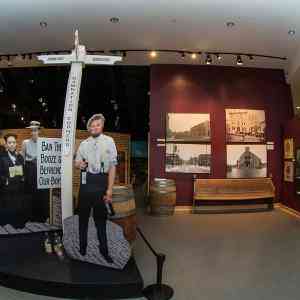Thanksgiving Closure
Grey Roots Museum & Archives will be closed Oct 12, 13 & 14.
Grey Roots Museum & Archives will be closed Oct 12, 13 & 14.

Until 1860, the only dock in Owen Sound was Boyd’s Wharf, owned by the government and located just outside the mouth of the Sydenham River. The Owen Sound Harbour, as it is located today, was inaccessible, due to a sandbar that ran across the mouth of the river.
This changed when Captain William Henry Smith arrived in Owen Sound (c. 1855) and began petitioning the government to dredge the sandbar. It took five years, but eventually they listened to his request. [[1]]
Captain Smith was born on May 7, 1826 in Cornwall, Ontario. Before moving to Owen Sound he worked in Chatham, Ontario with his future brothers-in-law, William and Walter Eberts, running the Oxford (a 90-foot paddle steamer) from Chatham to Detroit. In 1853, he married Francis Jane Eberts in Detroit, and two years later he brought the Oxford to Owen Sound. With the Oxford, he established the first Owen Sound to Collingwood run, connecting Owen Sound and the surrounding area to the Toronto railway. He advertised that one could go from Owen Sound to Toronto in one day—albeit in 24 hours.
Captain William Henry Smith, copy of photograph from the Scott Cameron Collection (PF102)
The Oxford was retired in 1856 as it was too small to meet the growing demand for this route. Captain Smith replaced it with the Canadian in 1856, a larger and faster steamer. In an advertisement in the Owen Sound Comet on May 27, 1857, he boasted:
The Fast-Sailing Low Pressure Steamer “Canadian” / Captain W.H. Smith / Through from Toronto to Owen Sound in NINE HOURS, by way of the Ontario Simcoe and Huron Railroad to Collingwood, and steamer Canadian to the Sound. / This is the cheapest and most direct route to St. Vincent, Euphrasia, Artemesia, Holland, Glenelg, Sullivan, Brant, Bentinck, Greenock, Kincardine, Bruce, Saugeen, Elderslie, Arran, Derbie, and the new Townships of Keppel and Amabel. / The Canadian will leave Collingwood for Owen Sound every day (Sunday excepted) at 1:30 p.m.; returning, will leave Owen Sound every morning (Sunday excepted), at 8 a.m.[[2]]
Four years, later, Captain Smith once again changed boats, this time purchasing the steamer Clifton, which was built at the Chippewa boat works. It was with this boat that he would finally achieve his dream of dredging the Sydenham River.
Although he had been pressing the government to take action since his arrival to Owen Sound in 1855, the government continued to deny his requests, stating that only navigable waterways were to be dredged. Due to the sandbar, the Sydenham River was deemed unnavigable, something that Captain Smith would have to disprove to acquire government funding. In 1860, using the Clifton and its convenient shallow keel, he ordered his crew to strip the boat and carry her anchors across the sandbar. The weight of the anchors pulled the Clifton across the sandbar. Once across, the boat was anchored outside Smith’s home at the corner of 11th Street and First Avenue East, and Captain Smith took photographic proof of the Sydenham River’s navigability. With this photograph in hand, he travelled to Quebec where Canada West’s government was forced to grant him the considerable sum of $12,000 to dredge the sandbar. In the summer of 1861 a pathway 110 feet wide and 12 feet deep was created. [[3]]
Captain Smith went on to build the Peel Waterhouse at the foot of 11th Street, and in 1866 – 1867 commissioned the shipwright Melancthon Simpson (from Thorold, Ontario) to build the Frances Smith in Owen Sound. It was the largest vessel built to date on Georgian Bay at 190 feet, and was described as “the finest passenger steamer in her time on the upper lakes.”[[4]] At her launch on April 30, 1867, the businessmen of Owen Sound presented Captain Smith with an illuminated address (now housed in the Grey Roots Archives). In response, Captain Smith spoke about the future of shipbuilding and of the Frances Smith on Georgian Bay:
I feel, gentlemen, that this my first effort at building, may and will be followed by many others; and should this noble vessel astonish the finny tribes of Georgian Bay by her speed, as I am sure she will, the entire credit will be due, to her designer and builder, Mr. Simpson. Gentlemen, I again most cheerfully thank you for your magnificent present, and kind wishes for myself and family, and I trust that the new ship may long be spared to float those beautiful colours to the gentle breeze.[[5]]
The construction of Frances Smith marked the beginning of shipbuilding on Georgian Bay, which would continue for more than 100 years. [[6]]
Postcard of the steamer Frances Smith (1872 – 1888) from the Cliff McMullen collection (PF95)
When Captain Smith died on November 9, 1871, the citizens of Owen Sound honoured his death with the largest funeral to date in the city, closing schools and businesses in his honour.
The Smith family continued in the shipping industry after his death with his nephew, Captain William Tate Robertson, taking over the Frances Smith, and his son, Henry Eberts becoming involved in the Collingwood shipyards. [[7]]
Captain Smith’s perseverance brought the shipping industry to Owen Sound, which continues to be a defining feature of the city today.
[[1]] Renewal of a Canadian Port by Melba Morris Croft (1993), p. 71
[[2]] Owen Sound Comet, May 27, 1857
[[3]] The Port City by Paul White (2000), pp. 72 – 75
[[4]] Fourth Entrance to Huronia: The History of Owen Sound by Melba Morris Croft (1980), p. 103.
[[5]] Owen Sound Comet, May 3, 1867
[[6]] More information on the Frances Smith can be found in The Frances Smith: Palace Steamer of the Upper Great Lakes, 1867 – 1896 by Scott L. Cameron (2005)
[[7]] Owen Sound: Steamboat Days by Andrew Armitage (1981), pp. 71 – 74

Your membership will grant you access not only to Grey Roots, but also to our partner museums!

Volunteers participate in learning workshops and seminars, meet new people and make new friends, and receive many benefits.

We rent our multi-media theatre and Delton Becker Room to the community. The 75 seat theatre is an excellent venue to host films, lectures and other events.